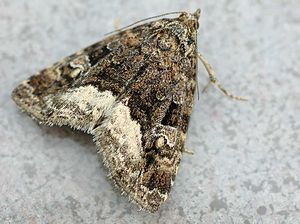Forest grass moth owls
| Forest grass moth owls | ||||||||||||
|---|---|---|---|---|---|---|---|---|---|---|---|---|

Forest grass moth owls ( Protodeltote pygarga ) |
||||||||||||
| Systematics | ||||||||||||
|
||||||||||||
| Scientific name | ||||||||||||
| Protodeltote pygarga | ||||||||||||
| ( Hufnagel , 1766) |
The forest grass moth owl ( Protodeltote pygarga ) is a butterfly ( moth ) from the family of the owl butterflies (Noctuidae).
features
The moths reach a wingspan of 23 to 25 millimeters. The head, prothorax and mesothorax as well as the midfield and the fringing of the forewings are dark brown to blackish brown with interspersed black and white scales . The metathorax , the basal area with the exception of the costal margin, the outer transverse line radiating broadly into the edge area and the wavy line as well as the borders of the ring and kidney blemishes and the punctiform cone blemishes are white. The fringes are checked in black and white. The outer and inner transverse lines are mostly black towards the middle field. The hind wings are brownish gray with a dark central spot and a light transverse line, mostly darkened towards the edge. The fringes are white and gray piebald. The abdomen is gray with whitish rings.
The egg is light yellow. It is conical, the tip is somewhat blunted. The outside shows numerous, slightly wavy longitudinal lines.
The caterpillars are initially green, with the back being a little lighter in color. The back line is gray, the side back lines whitish, as are the side stripes. In later stages, the caterpillars turn yellow.
The doll is yellow-brown and stocky. The cremaster has two points and some bristles.
Geographical distribution and habitat
The species is distributed across Europe including Scandinavia . In the east, the distribution area extends over Asia Minor , northern Iran, Afghanistan, southern Siberia, Central Asia, China to Sakhalin , Korea, Japan and Taiwan . In the vertical, the species occurs from the flatlands up to 1000 m in the Alps. The species prefers moderately moist to dry forest clearings, clearcuts, forest fringes and rows of bushes. The spectrum ranges from pure deciduous forests to mixed forests and pure coniferous forests. More open habitats are also mentioned as habitats: semi-arid grasslands, abandoned vineyard slopes, quarries and gravel pits.
Way of life
The species is mostly univoltin , i.e. H. only one generation is formed each year. The moths fly from mid-May to mid-August. In favorable years and in the south, an incomplete second generation is formed, the moths of which fly from late July to August. They rest in the vegetation during the day, but can be easily roused. They are nocturnal and fly to artificial light sources. The moths can be baited. The caterpillars feed on blue whistle grass ( Molina caerulea ), cane grass ( Phalaris arundinacea ) and land saddle grass ( Calamagrostis epigejos ) The following are also listed: pinnate twinkles ( Brachypodium pinnatum ), wood twinkles ( Brachypodium sylvaticum ), common knääula ( D ) and "other forest grasses". Pupation takes place on the ground under leaf litter. The pupa hibernates.
Systematics and nomenclature
The species was first scientifically described in 1766 by Johann Siegfried Hufnagel under the name Phalaena pygarga . Further early descriptions were made in 1775 by Michael Denis and Johann Ignaz Schiffermüller as Noctua fuscula , in 1785 by Sigismund von Hohenwarth (also wrote Siegmund von Hochenwarth) as Phalaena ployeri , 1790 by Eugen Johann Christoph Esper as Phalaena Noctua polygramma and 1809 by Adrian Hardy Haworth as Noctua albilinea , which are therefore considered to be younger synonyms. Other, more recent synonyms, the types of which come from other regions, are: Bryophila guenei Fallou, 1864 and Lithacodia fasciana coreana Bryk, 1948.
Phalaena pygarga Hufnagel, 1766 is the type species of the genus Protodeltote Ueda, 1984.
Danger
The species is not endangered in Germany.
swell
Individual evidence
- ↑ noctuidae.de - Bernd Schacht
- ↑ after Forster & Wohlfahrt, pp. 254/5
- ↑ after Ebert et al., Pp. 544-6
- ↑ Ingrid Altmann - Butterflies and their ecology
- ↑ Red lists at science4you
literature
- Arno Bergmann: The large butterflies of Central Germany. Volume 4/2: Owls. Distribution, forms and communities. Urania-Verlag, Jena 1954, DNB 450378381 .
- Günter Ebert (Ed.): The Butterflies of Baden-Württemberg Volume 5, Moths III (Sesiidae, Arctiidae, Noctuidae). Ulmer Verlag Stuttgart 1997. ISBN 3-800-13481-0
- Walter Forster , Theodor A. Wohlfahrt : The butterflies of Central Europe. Volume 4: Owls. (Noctuidae). Franckh'sche Verlagshandlung, Stuttgart 1971, ISBN 3-440-03752-5 .
Web links
- www.lepiforum.de Taxonomy and photos
- Ian Kimber: Guide to the moths of Great Britain and Ireland (English)
- Moths and Butterflies of Europe and North Africa (English)
- Markku Savela's Lepidoptera and some other life forms
- Deltote (Protodeltote) pygarga at Fauna Europaea